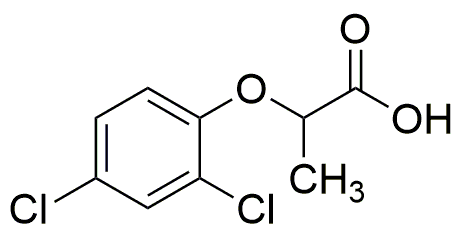2-(2,4-Dichlorophenoxy)propionic acid is widely utilized in research focused on:
- Agriculture: This compound serves as a herbicide, effectively controlling broadleaf weeds in various crops, enhancing yield and crop quality.
- Pharmaceuticals: It is studied for its potential anti-inflammatory properties, contributing to the development of new medications for conditions like arthritis.
- Environmental Science: Researchers use it to assess the impact of chemical pollutants on ecosystems, helping to establish guidelines for safe chemical use.
- Material Science: The compound is explored for its role in creating advanced materials, particularly in coatings that require resistance to environmental degradation.
- Analytical Chemistry: It is utilized as a standard in various analytical techniques, aiding in the accurate quantification of similar compounds in complex mixtures.
General Information
Properties
Safety and Regulations
Applications
2-(2,4-Dichlorophenoxy)propionic acid is widely utilized in research focused on:
- Agriculture: This compound serves as a herbicide, effectively controlling broadleaf weeds in various crops, enhancing yield and crop quality.
- Pharmaceuticals: It is studied for its potential anti-inflammatory properties, contributing to the development of new medications for conditions like arthritis.
- Environmental Science: Researchers use it to assess the impact of chemical pollutants on ecosystems, helping to establish guidelines for safe chemical use.
- Material Science: The compound is explored for its role in creating advanced materials, particularly in coatings that require resistance to environmental degradation.
- Analytical Chemistry: It is utilized as a standard in various analytical techniques, aiding in the accurate quantification of similar compounds in complex mixtures.
Documents
Safety Data Sheets (SDS)
The SDS provides comprehensive safety information on handling, storage, and disposal of the product.
Product Specification (PS)
The PS provides a comprehensive breakdown of the product’s properties, including chemical composition, physical state, purity, and storage requirements. It also details acceptable quality ranges and the product's intended applications.
Certificates of Analysis (COA)
Search for Certificates of Analysis (COA) by entering the products Lot Number. Lot and Batch Numbers can be found on a product’s label following the words ‘Lot’ or ‘Batch’.
*Catalog Number
*Lot Number
Certificates Of Origin (COO)
This COO confirms the country where the product was manufactured, and also details the materials and components used in it and whether it is derived from natural, synthetic, or other specific sources. This certificate may be required for customs, trade, and regulatory compliance.
*Catalog Number
*Lot Number
Safety Data Sheets (SDS)
The SDS provides comprehensive safety information on handling, storage, and disposal of the product.
DownloadProduct Specification (PS)
The PS provides a comprehensive breakdown of the product’s properties, including chemical composition, physical state, purity, and storage requirements. It also details acceptable quality ranges and the product's intended applications.
DownloadCertificates of Analysis (COA)
Search for Certificates of Analysis (COA) by entering the products Lot Number. Lot and Batch Numbers can be found on a product’s label following the words ‘Lot’ or ‘Batch’.
*Catalog Number
*Lot Number
Certificates Of Origin (COO)
This COO confirms the country where the product was manufactured, and also details the materials and components used in it and whether it is derived from natural, synthetic, or other specific sources. This certificate may be required for customs, trade, and regulatory compliance.


